*NURSING > STUDY GUIDE > NSG 6020 WEEK 1 HISTORY AND ASSESSMENT STUDY GUIDE / NSG6020 WEEK 1 STUDY GUIDE (LATEST -2020): SOUT (All)
NSG 6020 WEEK 1 HISTORY AND ASSESSMENT STUDY GUIDE / NSG6020 WEEK 1 STUDY GUIDE (LATEST -2020): SOUTH UNIVERSITY
Document Content and Description Below
NSG 6020 WEEK 1 HISTORY AND ASSESSMENT STUDY GUIDE 1. Mr. Mosley has shortness of breath that has persisted for the past 10 days; it is worse with activity and relieved by rest. What type of data is ... this? 2. The 7 attributes of a symptom include: A. Associated symptoms B. Aggravating and/or relieving factors C. Location D. ALL OF THE ABOVE 3. The steps of the nursing process include: (check all that are correct) ADPIE A. IMPLEMENTATION B. DIAGNOSIS C. ASSESSMENT D. Setting up the environment for the interview Match the Therapeutic Communication Techniques with the appropriate statements: Having this procedure must have made you very nervous Match the Therapeutic Communication Techniques with the appropriate statements: Eye contact, facial expression, tone, volume Match the Therapeutic Communication Techniques with the appropriate statements: "Now you have said that the pain began one week ago, and comes and goes several time a day" Match the Therapeutic Communication Techniques with the appropriate statements: Begin with open-ended questions then getting more specific Match the Therapeutic Communication Techniques with the appropriate statements: "Let's talk about making a plan together for your nursing care" Match the Therapeutic Communication Techniques with the appropriate statements: "I understand how you might be upset about this" Match the Therapeutic Communication Techniques with the appropriate statements: "You did the right thing by coming to get care today. I will let you know what each test means" Match the Therapeutic Communication Techniques with the appropriate statements: Paying close attention to what the patient is saying Match the Therapeutic Communication Techniques with the appropriate statements: I. "I think we have all the information about your current symptoms. Now I will ask you some questions about your past health history" 5. Which of the following are subjective data? (choose all the apply) A. "I have a stomachache with diarrhea." B. The lunch sounds are clear throughout all areas upon auscultation. C. "Mother has had diabetes for 20 years." D. The skin is warm and dry to touch. 6. Place the problem listen in order of priority, most serious and urgent to least serious. A. Chest pain B. Smoking C. Low back pain for several months D. Bruised knee 7. Which of the following questions are leading questions? A. "You don't have any chest pain do you?" B. "Which of the following describes your pain: aching, sharp, or throbbing?" C. "Is your headache pain like a throbbing pain?" D. "How many stairs can you walk up before you become short of breath?" 8. The question "how many blocks can you walk before the leg pain occurs?" is asking for a graded response. (T OR F) 9. Which of the following are examples of primary prevention? (Choose all that apply) A. Immunizations B. Self-examination of skin lesions C. Health education D. Seat belts 10. Which of the following are examples of secondary prevention? (Choose all that apply) A. Hard hats, needle-free devices, sharps containers. B. Blood pressure screening at health fair. C. Control of the spread of tuberculosis. D. Dental sealants on children's teeth. 1. Mrs. Brody has brought his 16-year-old daughter, Mandy, for a school sports physical exam. Mandy's height is 65 inches, and she weighs 126 lbs. Mrs. Brody is concerned that her daughter is overweight. According to Mandy's BMI, what is your response? A. Mandy is overweight and needs to take diet pills. B. Reassure the mother that this is a normal body weight. C. Refer the patient to a nutritionist and psychologist because the patient is anorexic. D. Give the patient information about exercise and reduction of fat cholesterol in her diet because she is overweight. B - (126 X 700) / (65^2) = 20.9 - Underweight: BMI < 18.5 - Normal: BMI 18.5-24.9 - Overweight: BMI 25.0-29.9 - Obesity I: BMI 30.0-34.9 - Obesity II: BMI 35.0-39.9 - Extreme Obesity III: BMI ≥ 40 2. CAGE QUESTIONS CUT DOWN Have you ever felt the need to CUT DOWN on drinking? ANNOYED Have you ever felt ANNOYED by criticism of your drinking? GUILTY Have you ever felt GUILTY about drinking? EYE OPENER Have you ever taken a drink first thing in the morning (EYE-OPENER) to steady your nerves or get rid of a hangover? 3. Mr. Davis has just moved to town and comes to your office to establish care. You would complete a comprehensive health history with the patient. (T OR F) 4. Mrs. Tibbs is a 35 year old woman who is recently divorced. She complains that she is having difficulty sleeping, and she cannot seem to remember things lately. She has lost about 10 lbs. without trying and she stopped going to her yoga classes as she has lost interest. You decide to further screen Mrs. Tibbs for: A. Borderline personality disorder B. Post traumatic stress disorder C. Depression D. Menopausal mood swings 5. The one or more complaint causing the patient to seek care is the: A. Past medical history B. Chief complaint C. History of present illness D. Family history 6. The past history includes: (check all that apply) A. Over the counter medications the patient takes B. Allergies to mold and mildew C. Chickenpox as a child D. Father has heart disease 7. Personal and Social history items include: A. Smoking habits B. Goes to church every Sunday and prays daily C. Lives with spouse and 3 children D. Never wears a seatbelt 8. The waist circumference should be less than __ inches for women and less than __ inches for men. 9. You are taking a health history on 67-year-old Mrs. Smith. You notice she is talking coherently but changing topics very fast. This is called: A. Confabulation B. Circumlocution C. Flight of ideas D. Circumstantiality 10. You determine the need to assess your patient's higher cognitive functions. You use the following tools of assessment: (check all that apply) A. Ask your patient how much change she should receive if she gave $1.00 for a 78-cent item. B. Ask your patient when her anniversary is. C. Ask your patient to draw a clock face. D. Name the capital of a state B - PART OF COGNITIVE FUNCTION BUT NOT A HIGHER COGNITIVE FUNCTION 11. A 55-year-old bookkeeper comes to your office for a routine visit. You note that on a previous visit for treatment of contact dermatitis, her blood pressure was elevated. She does not have prior elevated readings and her family history is negative for hypertension. You measure her blood pressure in your office today. Which of the following factors can result in a false high reading? A. Patient is seated quietly for 10 minutes prior to measurement. B. Blood pressure cuff is tightly fitted. C. Blood pressure is measured on a bare arm. D. Patient's arm is resting, supported by your arm at her mid-chest level as you stand to measure the blood pressure. 12. A 50-year-old body builder is upset by a letter of denial from his life insurance company. He is very lean but has gained 2 pounds over the past 6 months. You personally performed his health assessment and found no problems whatsoever. He says he is classified as "high risk" because of obesity. What should you do next? A. Explain that even small amounts of weight gain can classify you as obese. B. Advise him to increase his aerobic exercise for calorie burning. C. Measure his waist. D. Place him on a high-protein, low-fat diet. 13. A 67-year-old retired janitor comes to the clinic with his wife. She brought him in because she is concerned about his weight loss. He has a history of smoking 3 packs of cigarettes a day for 30 years, for a total of 90 pack-years. He has noticed a daily cough for the past several years, which he states is productive of sputum. He came into the clinic approximately 1 year ago, and at that time his weight was 140 pounds. Today, his weight is 110 pounds. Which one of the following questions would be the most important to ask if you suspect that he has lung CA? A. Have you tried to force yourself to vomit after eating a meal? B. Do you have enough food to eat? C. Do you have heartburn/indigestion and diarrhea? D. Have you tried to lose weight? 14. Common or concerning symptoms to inquire about in the General Survey and vital signs include all of the following except: A. Fever and chills B. Cough C. Changes in weight D. Fatigue and weakness 15. Jenny is one of your favorite patients who usually shares a joke with you and is nattily dressed. Today she is dressed in old jeans, lacks makeup, and avoids eye contact. To what do you attribute these changes? A. She is running into financial difficulty. B. She is lacking sleep. C. She is fatigued from work. D. She is depressed. 16. You are beginning the examination of a patient. All of the following areas are important to observe as part of the General Survey except: A. Dress, grooming, and personal hygiene B. Level of consciousness C. Blood pressure D. Signs of distress 17. You are observing a patient with heart failure and notice that there are pauses in his breathing. On closer examination, you notice that after the pauses the patient takes progressively deeper breaths and then progressively shallower breaths, which are followed by another apneic spell. The patient is not in any distress. You make the diagnosis of: A. Ataxic (Biot's) breathing B. Cheyne-Stokes respiration C. Kussmaul's respiration D. COPD with prolonged expiration 18. You are seeing an older patient who has not had medical care for many years. Her vital signs taken by your office staff are: T 37.2, HR 78, BP 118/92, and RR 14, and she denies pain. You notice that she has some hypertensive changes in her retinas and you find mild proteinuria on a urine test in your office. You expected the BP to be higher. She is not on any medications. What do you think is causing this BP reading, which doesn't correlate with the other findings? A. It is caused by a cuff size error. B. It is caused by the patient's emotional state. C. It is caused by resolution of the process which caused her retinopathy and kidney problems. D. It is caused by an "auscultatory gap." 19. Attributes of a symptom includes: Location, Remitting or exacerbating factors, associated manifestations, setting in which occurs, quantity/severity Match the attributes of a symptom: "I have been applying cold packs and it seems to make me feel better." Remitting or exacerbating factors "The pain starts in my lower back and shoots down my left leg." "After I noticed the rash, then it really started itching." Every time I go outside when the queen palms are blooming, I start sneezing and my eyes get watery." "On a scale of 1 to 10, my lower back pain is about an 8." 20. When you enter the patient's examination room, his wife is waiting there with him. Which of the following is most appropriate? A. Ask if it is okay to carry out the visit with both people in the room. B. Carry on as you would ordinarily. The permission is implied because his wife is in the room with him. C. Ask his wife to leave the room for reasons of confidentiality. D. First ask his wife what she thinks is going on. [Show More]
Last updated: 2 years ago
Preview 1 out of 9 pages

Buy this document to get the full access instantly
Instant Download Access after purchase
Buy NowInstant download
We Accept:

Reviews( 0 )
$15.00
Can't find what you want? Try our AI powered Search
Document information
Connected school, study & course
About the document
Uploaded On
Jul 29, 2020
Number of pages
9
Written in
Additional information
This document has been written for:
Uploaded
Jul 29, 2020
Downloads
0
Views
112

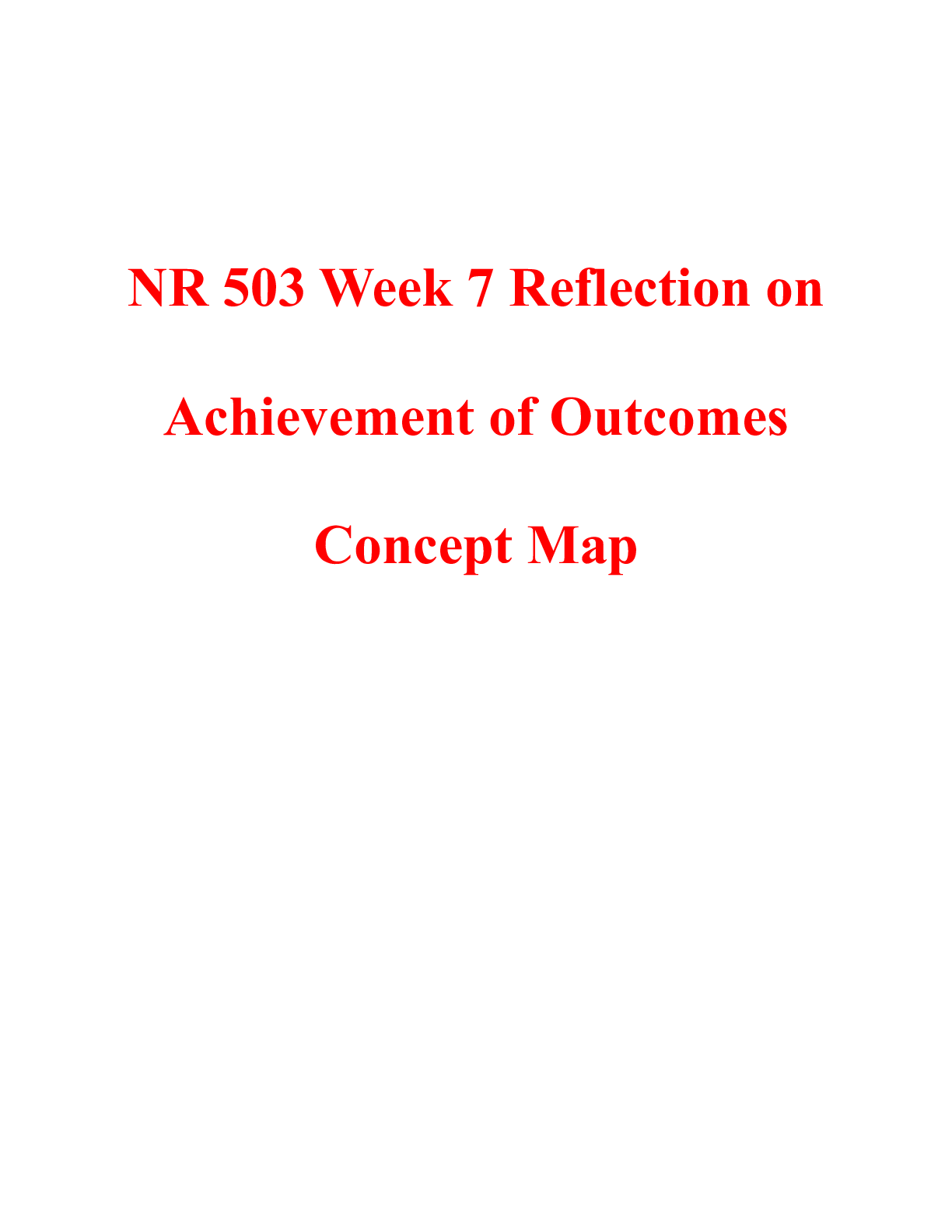


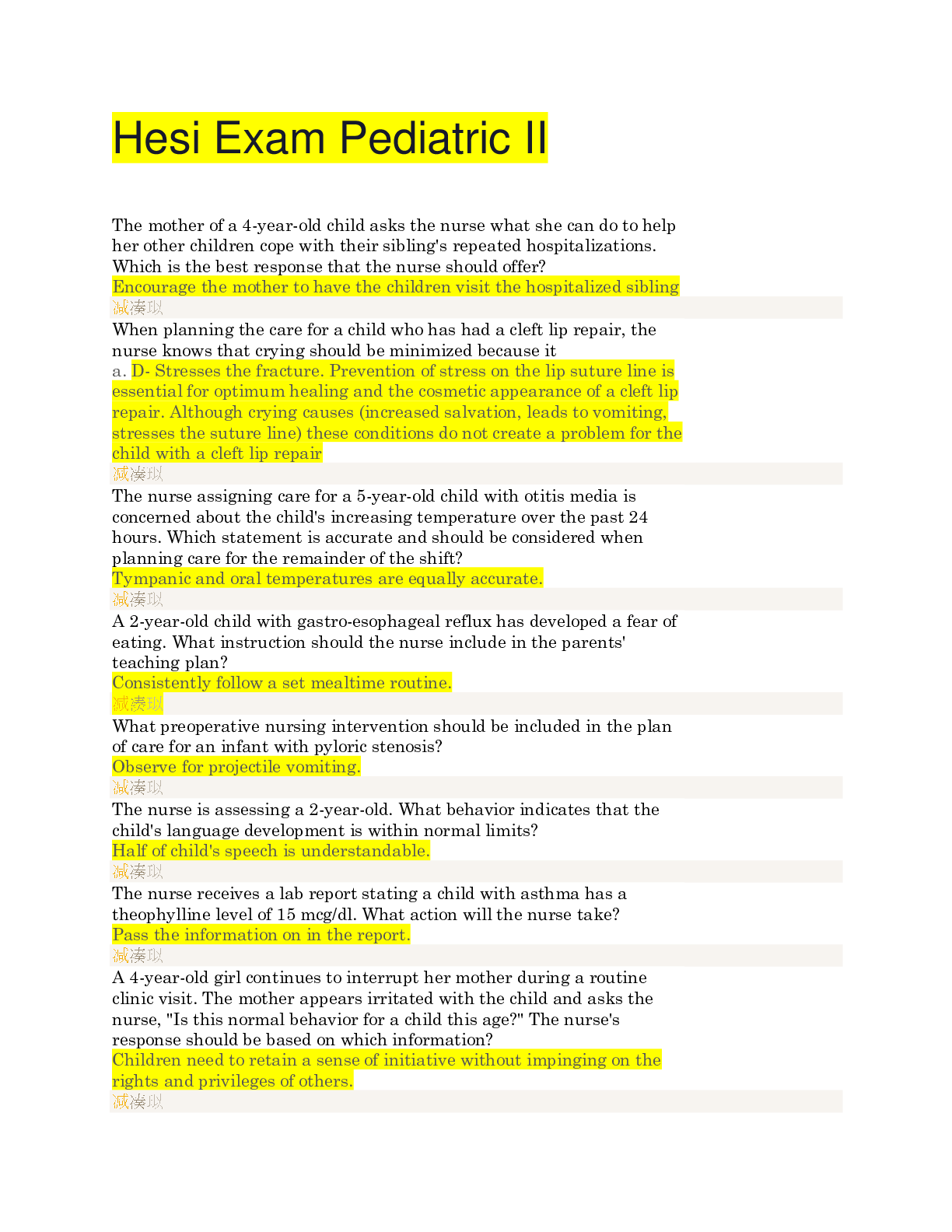





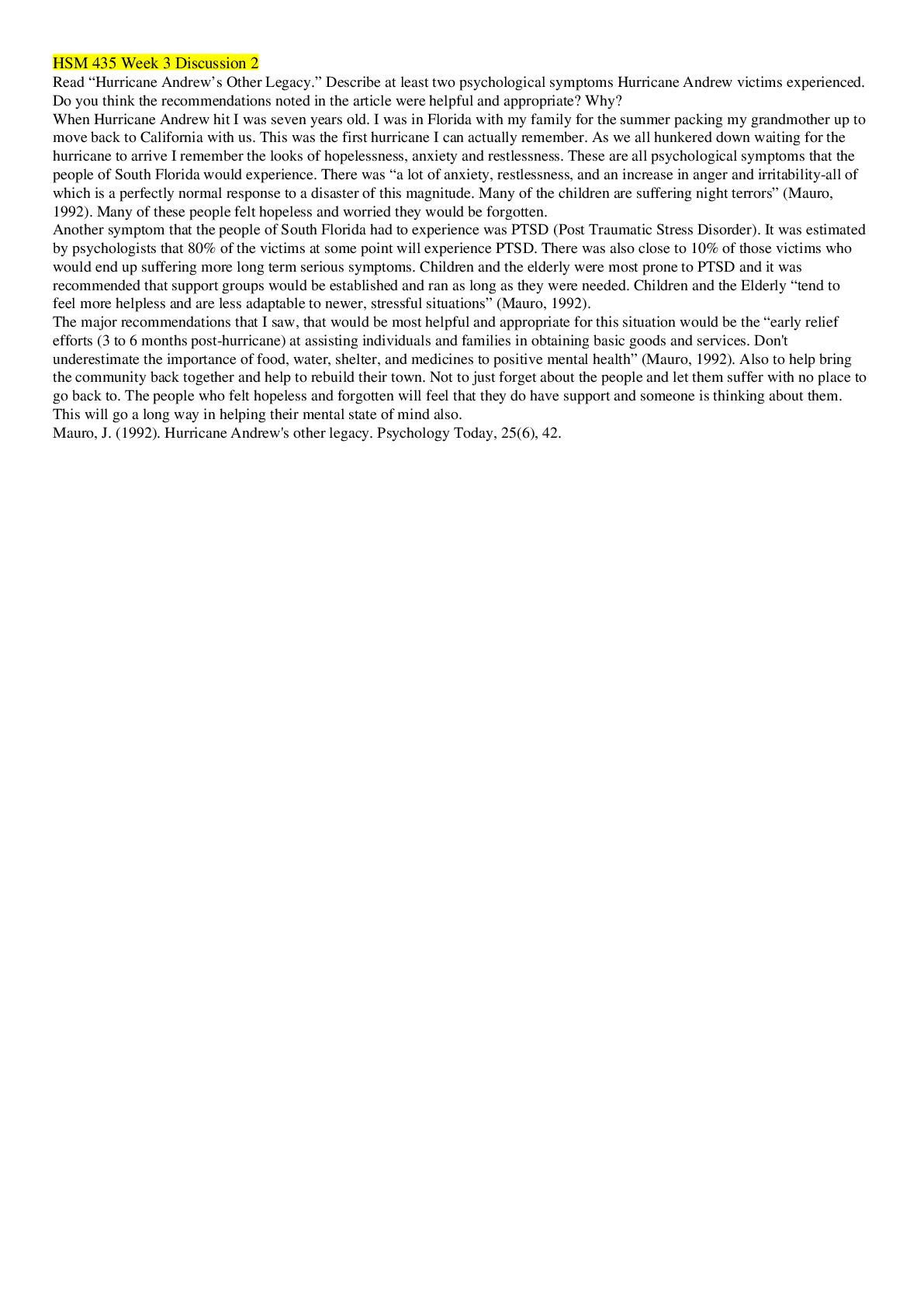


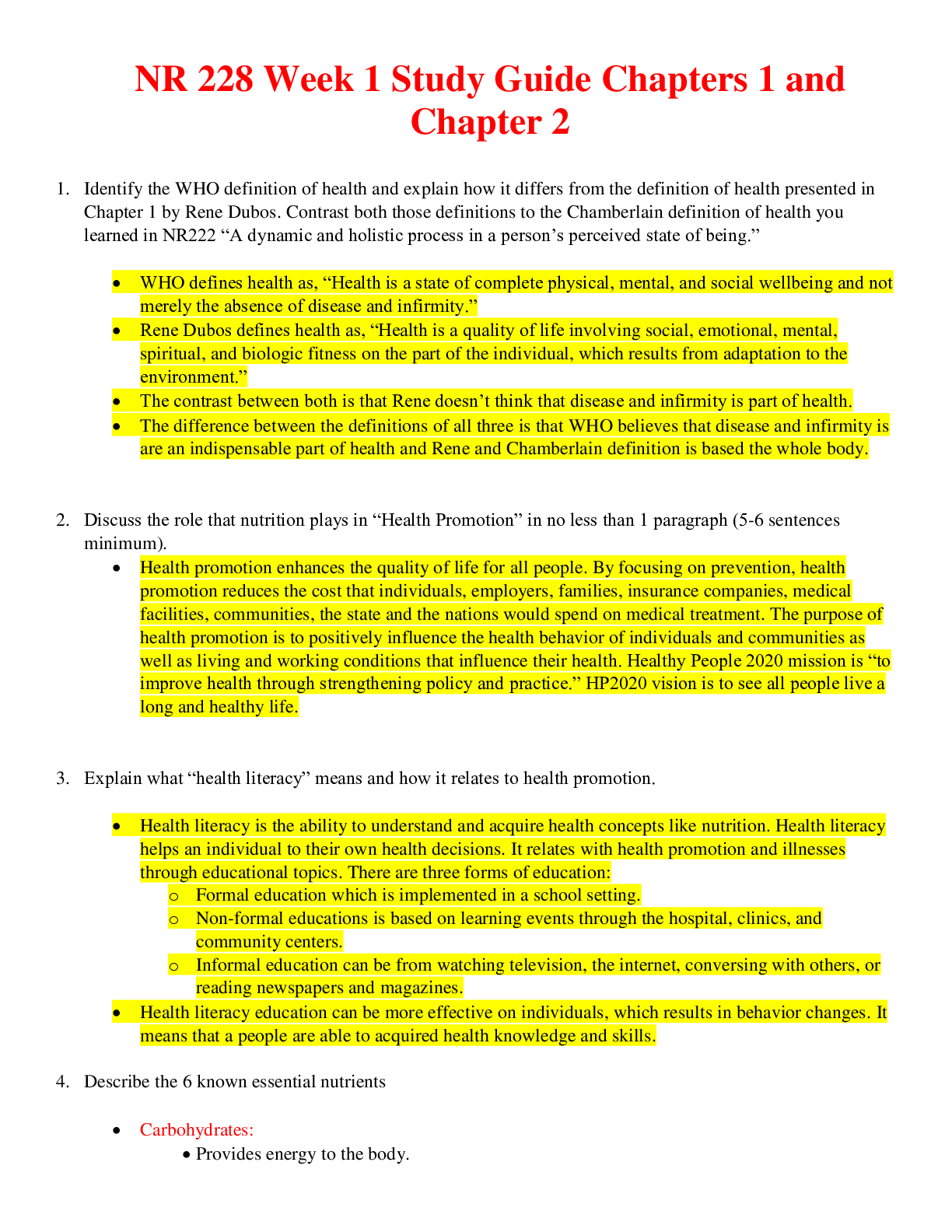
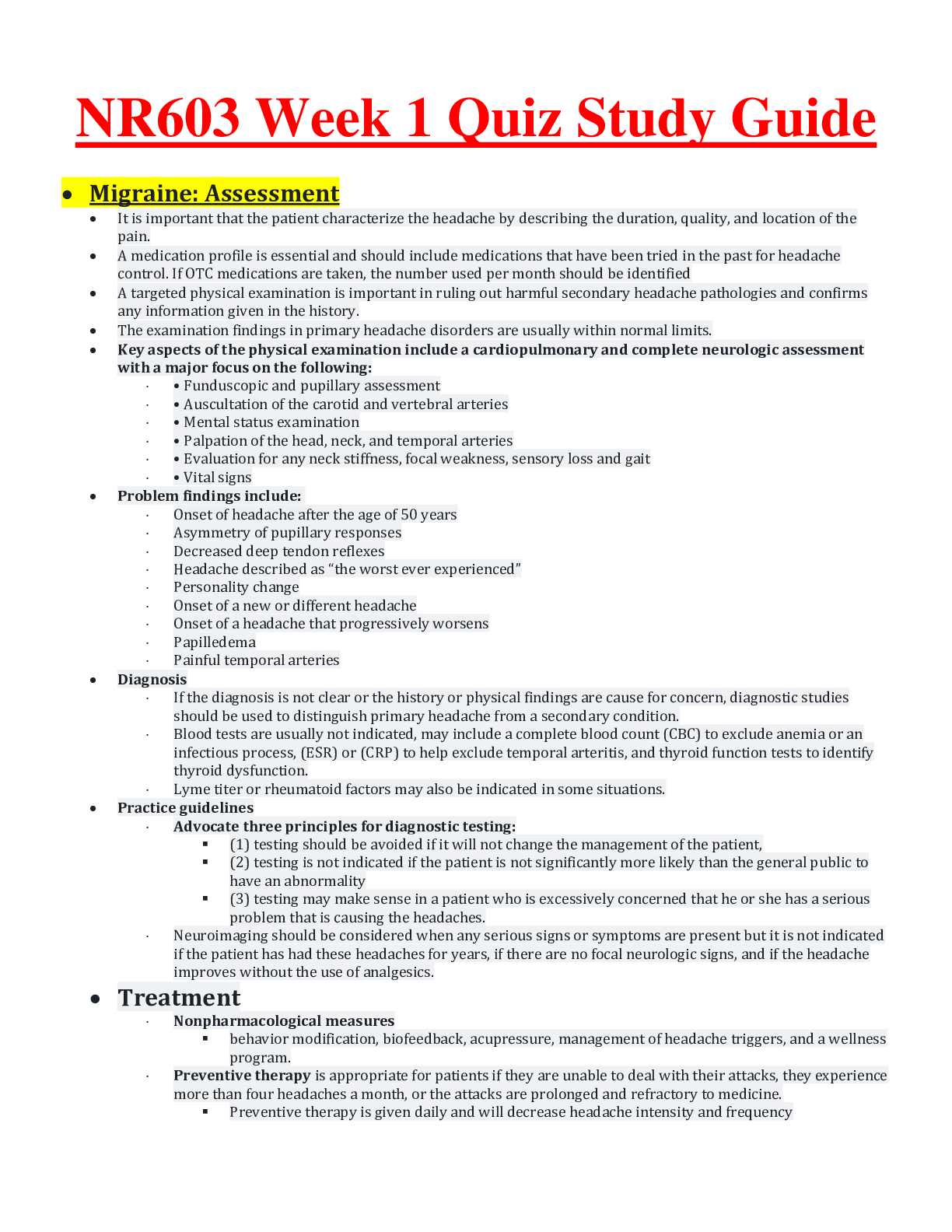





.png)
.png)




